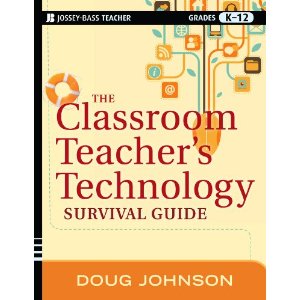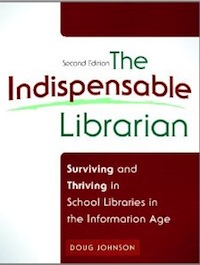Implementing an Information Literacy Curriculum
(Editing in progress…)
Implementing an Information Literacy Curriculum: One District’s Story
NASSP Bulletin, Mar 1999
About three years ago leaders in our district, like in many others, started to ask some serious questions about what our students need to know in order to work and live productively in tomorrow’s society. We had listened to the futurists in both business and education, and tried to relate some of those predictions, warnings, and advisements to what was happening in our community. Some of the important questions began to surface:- If everyone is to truly become a life-long learner, how are our students gaining the skills needed to use information to solve problems? How have the Internet and other electronic information sources changed the skills needed to do good research?- Are all our students learning needed computer productivity skills? What can students do now with computers that couldn’t be done when the last computer curriculum was written for stand alone Apple II computers?- How can both technology and library skills be not just taught as separate curricula, but applied and integrated throughout the content areas in meaningful ways?- How can the school meet new state graduation requirements that emphasize student problem solving, decision-making, and information literacy and how can we “authentically” assess the mastery of those skills?- How can we demonstrate that the huge investment that our district has made in technology is making a difference in how and what students are learning.
At the direction of the district’s media and technology advisory committee, the district’s media specialists, computer coordinator and I began to construct a combine library and technology curriculum that would be a true information literacy curriculum. The project was nicknamed “Agatha” after the popular “information problem solving” author Agatha Christie. At a departmental brainstorming sessions, we decided that we would start with our K-8 curriculum, and its revision would have the following outcomes:• The curriculum would be based on projects that resulted in products using a variety of media and formats.• The curriculum would teach useful technology skills primarily using productivity software.• Information literacy skills, rather than “library skills,” would help student learn not just how to find information, but use it.• Student research would ask for original “higher level” thinking, helping teachers and librarians combat both plagiarism and boredom.• The projects would be integrated into the classroom’s content areas and be team-taught between the librarian and the classroom teacher.• The projects would be authentically assessed, and the tools used to design those assessments would serve as models for other areas of the curriculum.• Students would leave middle school with core technology skills that would allow them to be productive in high school, relieving high school instructors of the responsibility of teaching technology “basics.” High school classes could emphasis the application of technology skills in specific content areas.• Above all, we wanted what the students were doing to be meaningful, and therefore, motivational.We also insisted that ALL our students complete the same curriculum. No longer would a teacher or media specialist’s personal enthusiasm (or lack thereof) for technology or research determine whether a student would get to practice using information skills.
1. Identify current skills.Our first step was to closely examine our current library and technology curricula and find exemplary models of curricula from other districts. We wanted to be sure that in our attempt to improve how our students were being taught, we did not drop skills that we had been teaching that were important. We took a considerable amount of time to write or re-write the skills we felt were critical in understandable, observable language. Everyone - teachers, parents and students - needed to be able to easily understand what students needed to be able to know and do. At this point, we also decided to list the productivity software for each grade level that would available on a district-wide basis. In other words, as teachers and media specialists planned projects and units, these would be the tools could they count on to be installed on every machine. We made sure that all software was cross-platform and that the district could afford the licenses. The list for K-8 was relatively short:• an integrated productivity bundle (ClarisWorks)• a simple desktop publishing program (The Writing Center)• a multimedia authoring tool (HyperStudio)• a drawing program (KidPix)• a simple spreadsheet (Cruncher)• a e-mail program (Eudora)• a web browser (Netscape)• the electronic library catalog (Follett)• an on-line electronic magazine index, age appropriate (ProQuest)• a networked encyclopedia (World Book)• a typing tutor program (Mavis Beacon)While I am not endorsing any of these specific products (others I am sure can be successfully substituted), we have been very satisfied with the products our students and teachers have been able to produce with these titles.
3. Group skills with in the process. Our final task as a group of “information professionals” was to group the laundry list of library and technology skills we had identified in Step One within the Big Six process. This proved to be surprisingly easy. Most skills feel naturally into one or more of the steps in the process, including technology skills.We did discover that we taught students little about Steps One and Six of the information literacy process: how to determine one’s information needs (Step One) and how to evaluate the project’s process and product (Step Six). We took an especially careful look at how we could design research topics that asked students real questions of genuine interest. It helped to review Bloom’s Taxonomy of Higher Level Thinking Skills. We also created a rubric by which to evaluate a research topic. (Appendix 1) A copy of our efforts can be found at <http://www.isd77.k12.mn.us/resources/infocurr/infolit.html>. Dr. Eisenberg and I also developed a similar curriculum that specifically and more comprehensively grouped only technology skills with in the Big Six. The ERIC document of that effort can be found at <http://www.ed.gov/databases/ERIC_Digests/ed392463.html>.
4. Identify areas in the curriculum for integration. We had done as much as we could without major collaboration with classroom teachers. Since we wanted a uniform curriculum and set of projects across the district, we need to involve at least one teacher from each of our buildings from each grade level. We met, however, one grade level at a time with all the media specialists for two mornings during Year Two. Our first morning was devoted to familiarizing these teachers with the concepts of information literacy and the Big Six process. We did this by asking them to complete a series of information literacy activities including choosing a movie to see, planning a vacation, organizing a Thanksgiving dinner for a visiting family of Buddhists, and helping a son or daughter decide whether to buy a business. Each of these activities allowed teachers to experience designing a good research question, identifying needed information, determining sources of that information, and evaluating the outcome. The second task involved creating a curriculum map for each grade. A common complaint among teachers is that there is too much curriculum to successfully teach. So as we looked at units of study in which to integrate information literacy skills, we wanted to be sure we were teaching information literacy units within already taught units, not adding new units. A simple curriculum map created in less than an hour gave us what was actually, rather than officially, being taught. We were careful to select units for information literacy units that were considered by the classroom teachers to be weak due to poor activities or little support materials currently available. This was important because we did not want to take the chance of possibly making successful units weaker, only poorer units better. Information literacy projects need to be viewed as helpful to the classroom teacher, not just additional work. At the secondary level, departments are imbedding technology skills within “packages” which are required for all students to meet the state’s graduation requirements. Content areas identify information literacy and technology skills that are required for the completion of these packages. We expect most students to come to the high school already possessing these skills.
6. Identify needed resources. Now that we had an idea of what units and what projects we wanted our students to complete, we needed to closely look at the resources we would need to put this in place. Was it realistic to ask all seventh grade students to do a multi-media project, for example, if there were only ten computers and no multi-media software available? But once we had the topics and project types we wanted to implement, we could start focusing our technology and software purchases directly toward these units. The amount of resources available also determined the phase-in period of the projects. The less resource intensive the project, the earlier it could be implemented.Another important but often overlooked “resource” is the skill level of the teaching staff. As we looked at the projects that we hoped to teach, we recognized there were definite areas where we needed to focus staff training efforts. While most teachers could help students with word processing, e-mail, and graphics use, only a few individuals felt comfortable enough with hypermedia, databases, and spreadsheets to use those applications as part of a project. This is where the media specialists stepped in to offer their support by team-teaching newer, more complex technology skills. As the media specialists taught, the teachers could learn with the students.
8. Develop a record-keeping and reporting system. We realized we needed to share the results of our assessments with students and their parents. As a result we added new fields to the computerized elementary progress report for media/technology skills Media specialists now report whether students have achieved mastery of skills for each student in their school.Skills have been grouped into four main areas for which K-8 grade level benchmarks have been written. <http://www.isd77.k12.mn.us/resources/infocurr/benchmark.html>. The benchmarks are important, especially for letting parents know what skills their children are expected to master. Note that the benchmark skills reflect the information literacy curriculum and are tied to the project unit through the project assessments. Our next step will be to aggregate the data on a building and district-wide basis for reporting the school board and community. We need to be able to both clearly describe the skills and be able to report the percentage of our students mastering them.
Lessons:
We found that is was also critical to involve others, especially teachers, as we developed the curriculum:• The impetus for the curricular change came from a group representing a wide segment of both the school and the community. The advisory group did just that: advised us to develop ways to meaningfully use technology and our libraries.• Media specialist and teacher collaboration and dialog were critical to integration of information literacy in the curriculum. Our approach that this curriculum was not an add-on to the current content areas, but a different and more effective method of teaching was very important. It also became clear that neither the classroom nor the media center could do the job alone. Skills taught in the media center needed to be reinforced in the classroom, and vice-versa.• Our approach helped teachers understand that students are more motivated when skills are applied in meaningful, creative ways, and this especially true with technology. The “why” of learning, not just the “how,” is keeping our schools and classrooms relevant in children’s lives. Our media specialists and teachers have worked hard on this change project, but are recognized now as district leaders. The process has been difficult, challenging, time consuming, confusing at times, and the product will always be a state of flux. But in the end, out students and our community will be the better for our efforts. And that’s the bottom line.
From: The Indispensable Teacher’s Guide to Computer Skills. Linworth, 1998. 800-786-5017 Figure 1: Unit design model





Reader Comments